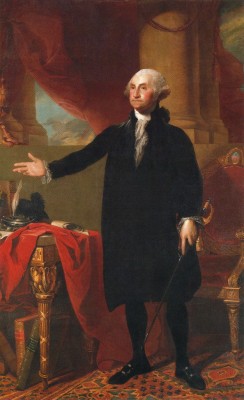The Collection of the White House
November 06, 2012
The White House’s first work of art was acquired in 1800. It was a painting, and it depicted, perhaps not surprisingly, that most beloved forefather of forefathers, George Washington. By Gilbert Stuart, 1797, it is also probably one of the most recognizable pieces of art the White House displays today.
All of our presidents have had their likenesses painted, and framed works featuring the First Ladies also watch over in the halls and rooms of the White House. But this historic building, residence, and political hub is more than a Hall of Fame of our country’s leaders. It is also a museum in its own right, with a pretty fantastic fine and decorative arts collection that spans centuries.
A 1938 Steinway creates just the right touch of patriotism with legs supported by gilt American bald eagles. Steinway began as Steinway & Sons in the 1850s, a firm of hand-built pianos started by a German immigrant to New York City. This piano was a custom work, a gift to the White House from its manufacturer in 1938.
In the Cross Hall—the central corridor extending from the East Room to the State Dining Room, hangs this cut-glass chandelier with swags like an elegant headdress. It’s attributed to the London glass manufacturer William Parker, ca. 1774. Parker was a name synonymous with quality and beauty; even British royalty commissioned his firms for decorative and household objects.
A sinewy tea urn of Sheffield silverplate and ivory stands in contrast to the deep jade hues of the Green Room. The artist is unknown, but it was created in ca. 1785. John and Abigail Adams were the original owners; the object was donated back to the White House in the 1960s.
John Singer Sargent’s lush brushwork depicts a dark, shroud-like protective barrier against luxurious satin bedclothes in The Mosquito Net, 1912. This was one of Sargent’s private works, which he kept until the end of his life.
This little Swiss Army knife of a work table, also in the White House’s Green Room, has a number of puzzle-like drawers but when shut, is no more obtrusive than an elegant mahogany podium. It’s attributed to Duncan Phyfe, ca. 1810.
Devastation struck the White House in 1814 when British forces burned Washington during the War of 1812. Famously, Dolly Madison saved the portrait of George Washington you see above by cutting it from its frame before fleeing the burning building.
To refurnish the formal reception space known as the Blue Room in the years that followed, James and Elizabeth Monroe attempted to purchase a set of mahogany furniture from Paris. Instead—blame the purchasing agents—a gilded suite arrived from abroad, 53 pieces in all by Pierre-Antoine Bellangé. All were sold at auction in 1860, but eight original pieces have been returned in the last 50 years.
Because we are housed in a historic mansion, there are plenty of opportunities to display timepieces from the Driehaus Collection, such as a French clock by Deniére in the gallery formerly known as the Nickerson library. Perhaps this is why we’re partial to the delicately understated, gilded mantel clock sitting in the Blue Room. It is also by French clockmaker Deniére et Matelin, fashioned in ca. 1817.
Rocky Mountain Landscape by Albert Bierstadt in 1870, conveys for the viewer a sense of the sublime—see those craggy peaks? The awe-inspiring landscapes of the American West were great fodder for the artists who strove to create that terrifying-yet-beautiful emotion nature can conjure.
A handful of works by the American portraitist Charles Bird King, of Rhode Island gives a sense of the depth of North American history to the White House Library . Although King won commissions during his career as an artist from the Washington, D.C. elite (he painted John Quincy Adams, Henry Clay, and James Monroe), he is best known for his depictions of Native American leaders as part of a federal project to collect their portraits. (Shown above: Hayne Hudjihini (Eagle of Delight), Oto by Charles Bird King, c. 1822.)
The crisp, airy aesthetic of the Vermeil Room comes from its creamy paneled walls and highlights from the collection of gilded silver that gives it its name. A collector named Margaret Thompson Biddle bequeathed to the White House her 1,575 vermeil pieces by the greatest silversmiths of England and France in the 18th and 19th centuries. Not bad for a room that used to be servants’ quarters. Shown above, a tureen and stand by James Young, 1779.
The moniker for the room you’ll find this plate in is another giveaway: the China Room is an exhibition space for presidential china, silver, and glassware. Most are quite formal and patriotic, but this Gilded Age-era oyster plate from Ruherford B. Hayes’s service is stunning in its color and organic forms. (Haviland & Co., 1880)
We’ll find out tonight which contender, Mitt Romney or President Barack Obama, will temporarily inherit (or re-inherit) this museum. Whoever will be our president this term, he will certainly be surrounded by a beautiful history as told through these objects.
All photos and information about the objects above are courtesy of the United States White House. http://www.whitehouse.gov/about/inside-white-house/art#overview